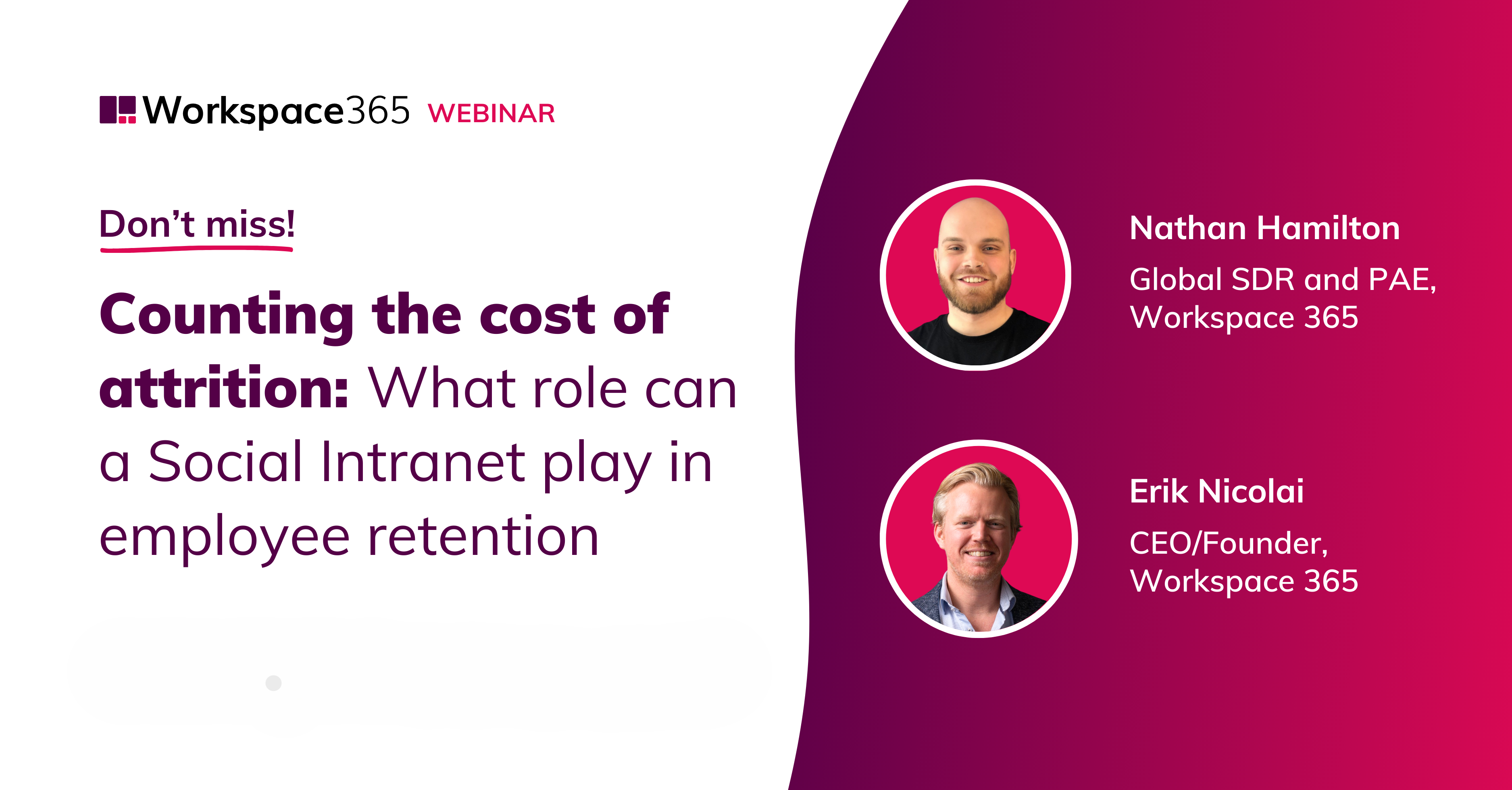The term Digital Employee Experience is relatively new and you see it more and more often. But what exactly does it mean? How does it differ from the Employee Experience, and how important is it to your organisation? In this blog, I'm happy to explain to you what Digital Employee Experience is and how you improve it.
What is Digital Employee Experience (DEX)?
The Digital Employee Experience is often defined as 'All digital interactions within the work environment' or 'the impact of technology on the Employee Experience'. If this was all the explanation needed to describe the Digital Employee Experience, this blog wouldn't have been necessary.
The Digital Employee Experience is, as it were, a part of the Employee Experience, which we'll get into later on in this blog, and refers to the experiences employees have with technology within an organisation: which tools do they use? How user-friendly are these tools? And do people learn how to use them? Do they have all the tools they need? How connected are the different tools with each other? A good or bad Digital Employee Experience can have a big impact on your organisation. A study by Nintex even showed that 86% of the American respondents who were looking for a new job, did this due to defective processes.
To better understand what the Digital Employee Experience means and how important it is to your organisation, we'll go back to where it began: the Customer Experience.
It began with Customer Experience (CX)
When organisations started to comprehend that solely sending out messages wasn't enough to attract customers (Buy me! Buy me!) and especially retaining them, an increasing amount of attention was paid to the Customer Experience. Selling was no longer the one and ultimate goal; it wasn't just about offering the best product anymore, but also about the experience of the customer. Before, during and after the purchasing process. Think for instance of giving advice, the experience of the customer in the store or on the website, and the service regarding warranty, exchanges and returns.
The role of the employee in Customer Experience
And who provides this service? Who makes sure a customer feels good about completing a transaction, or always looks to your company first because of the pleasant support? That's right, the employee. They play a crucial part in a successful Customer Experience, and more and more organisations started to see this too. Thus, the rise of the Employee Experience.
What is the Employee Experience?
According to Bersin, the Employee Experience is 'The sum total of all the touchpoints an employee has with his / her employer, from the time of being a candidate (active or passive) to becoming an alumnus / alumna.'
The Employee Experience is the experience of the employee regarding the culture, such as core values, how they are upheld and the behaviour within the organisation, among other things. How people are being treated, how feedback is given and whether or not people are praised for a job well done. If a person feels involved with the team and gets the opportunity to learn. It is also the experience of an employee regarding the physical space and the technology they work with.
Furthermore - to make it a bit more complicated - the Employee Experience also has to do with the expectations, needs and wishes of an employee, and to what extent these correspond with the reality. Nothing is more disappointing than a mountain of unfulfilled promises such as personal growth, or a completely different working atmosphere than you were told. Companies: talk the talk, walk the walk.
All in all, the Employee Experience is how an employee experiences your organisation and what emotions he or she connects to that. Before, during and after they work for you.
Why is the Employee Experience important?
The Employee Experience plays an essential role, and in many organisations, the employee is just as important as the customer. Not just because of attracting and retaining talent, but also because the effort of these employees determines your success. To illustrate:
- Engaged employees are 87% less likely to leave their organisation than less involved people.
- Organisations with engaged employees pull in 2.5 times more revenue compared to competitors with less engaged employees.
- Organisations with the best employee experiences have 12% higher customer satisfaction.
The difference between Employee Experience (EX) and Digital Employee Experience (DEX)
Where the Employee Experience is all about the complete experience of the employee with your organisation, the Digital Employee Experience is focused on the technological experiences of the employee. This, however, does not make the Digital Employee Experience any less important: his or her technological experiences can have a big impact on the experience as a whole.
The importance of a good Digital Employee Experience
Imagine you're trying to do your job to the best of your ability, but the tools you have to work with are complicated, you don't know how to use them properly or how to learn how to do so, or they're cumbersome and only get in the way of the efficiency of processes.
Such as when you can't watch a video because you're on a remote desktop, constantly have to search Google for certain web apps because you can't remember the URL, have to take a chance on which of the 10 versions of a document is the right one, or can't quickly finish a task because you've forgotten a password. Doesn't exactly sound like a productive way to work, does it?
Employees who deal with this on a daily basis are more likely to be reclusive, frustrated and unproductive. And as mentioned in the beginning of the blog, chances are that these employees will leave for these reasons. A shame, but understandable.
You also carry the risk that if employees don't get the right or user-friendly tools from the organisation, they'll go looking for ways to do their work on their own. This is a big cause of the arise of Shadow IT within organisations, which comes along with a whole set of its own risks.
Technology is increasingly intertwined with other parts of the organisation and each role. More and more people have to use technology in one form or another. That's why it's important to make sure they have an optimal Digital Employee Experience.
Improving the Digital Employee Experience
So how do you ensure a positive Digital Employee Experience, and how can you keep improving the Digital Employee Experience?
Do not only involve the IT department
It already starts with involving more people than solely from the IT department. Because while they're very skilled at working with certain tools, other employees might not be. It's also difficult for the IT department to fully determine what people need. The ones who know this best, are they people themselves. So always make sure there's a connection between the different departments and the people in it. Do they have everything they need? Which processes do they find difficult? And what could they use support with?
Offer training and support
The Digital Employee Experience revolves partially around using the right, user-friendly and efficient tools, but not exclusively. It's also crucial how people work with these tools, or in other words: if people know how to (optimally) use them, and can get help if they get stuck. Education and training are essential. People need to get a chance to learn how to work with (new) tools, and ask questions when they need to.
Adoption and onboarding
The aforementioned is especially important when you have new employees or new tools. Ensure a sufficient onboarding process for new employees, so that they can work efficiently and productively with the tools at their disposal from the start.
This goes for new tools and applications as well: you can't just introduce it and expect people to instantly be able to start working with it. Always make sure that in a case such as this, enough training or support materials are available. You can adjust this based on the impact of the transformation: is a small application added? A support article will suffice. Is it an entirely new workspace? Then you shall have to look into a complete organisation-wide adoption process.
Map the Digital Employee Journey
To help you improve the Digital Employee Experience in your organisation, you could map the Digital Employee Journey. This provides a picture of all digital experiences of an employee, from their job application and onboarding, until the time they leave. With which technology do they deal during these times? How do the employees experience this?
You could for instance look at how it was for them to apply for a job online: was this easy to find, or was it a complicated process with too many steps? Or for new employees: did they get enough explanation, or were they flung into the deep? Are there enough resources, so they can figure things out on their own or easily ask for help? Based on this, you can map the pain points and points of improvement, to ensure every employee has a positive Digital Employee Experience.
Unite and simplify your tools in one digital workspace
In many organisations, digital workspaces are getting more and more complex, with an increasing amount of tools, apps and information, all of which work separately from each other, spread out over multiple locations.
To simplify the entire workspace and the way people work, you can unite everything into one personal adaptive workspace. In it, an employee can find everything he or she needs to work daily, from information, applications, documents, news, intranet and more. Due to smart technologies, the workspace adapts automatically based on someone's role, location, device, browser and more. Consequently, they always have secure access to relevant tools.







